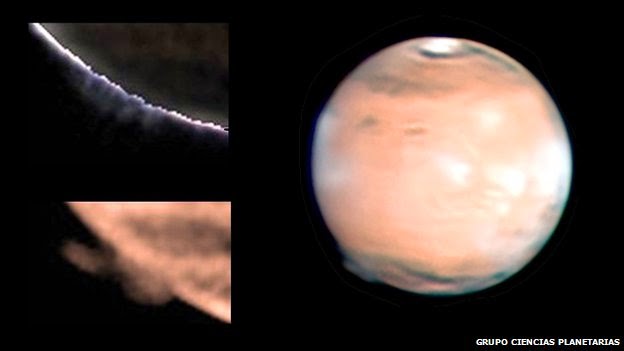 |
| Huge cloud plumes on Mars |
Observations have shown that the clouds fade during the Martian daytime, and then reappear each morning for at least ten consecutive days. The surface activity is taking place at night, no doubt to minimise the risk of detection by NASA’s or ESA’s orbiting probes. That strategy appears to have been successful, as the only observations of the clouds have been from Earth. Of course, it’s quite possible that the US and European space agencies have plenty of close-up evidence that is too sensational, or too distressing, to be released into the public domain.
So what could the purpose of the activity on Mars be? There are many possibilities, but the following two are most likely in my opinion:
1. Terraforming
The residents of Mars have had to live in subterranean domains for many hundreds of thousands of years since their planet’s ability to support them on the surface was lost. They have finally developed the required planetary engineering technology to transform and thicken the Martian atmosphere back its former liveable state. In 2012 the process was started. It is likely to take centuries to complete.
 |
| Mars at different stages of the terraforming process |
After many millennia living deep under the surface, and after accepting the fact that their once habitable planet is beyond recovery, the remaining population of Mars is evacuating. Launching at night, the evacuation spacecraft are heading to some location in the Solar System, most likely in the asteroid belt or Kuiper belt, where they will either join up and be reconfigured into a large generation ship, or dock with an existing generation ship constructed using the vast resources available in those regions. When the evacuation is complete and the generation ship ready it will embark on its interstellar journey to a new star system.
 |
| A Martian generation ship under construction in the asteroid belt |
I am hoping the evacuation is underway. When it’s completed it will provide us with a vast and deserted subterranean habitat on Mars, perfect for thousands and eventually millions of humans to live in, helping to ensure the survival of our species.
I've no doubt that the teams running the current Martian colonisation attempts, such as Mars One, are also hoping the evacuation scenario plays out.
No comments:
Post a Comment